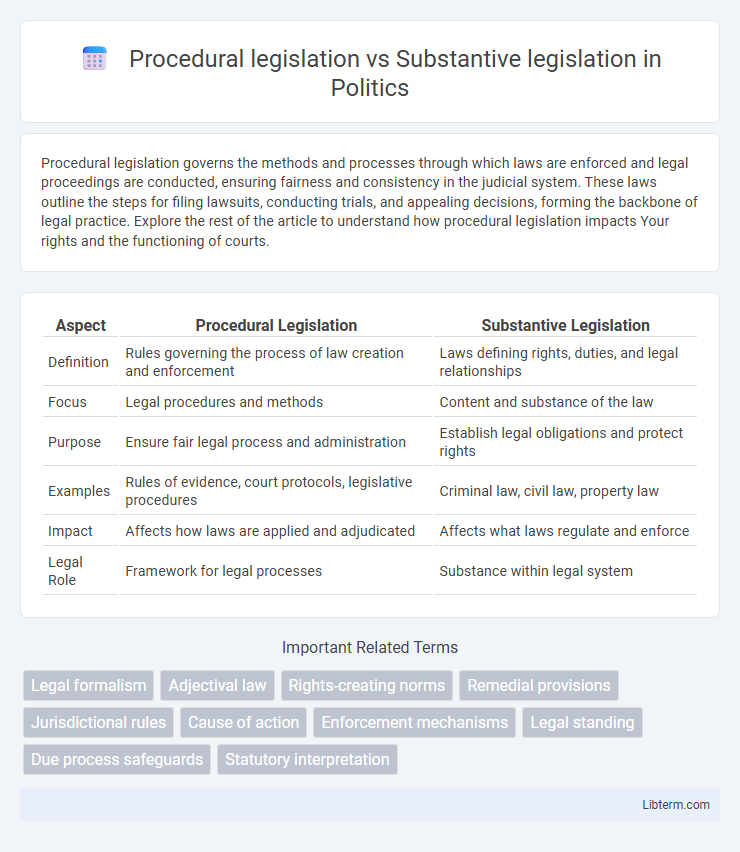Procedural legislation governs the methods and processes through which laws are enforced and legal proceedings are conducted, ensuring fairness and consistency in the judicial system. These laws outline the steps for filing lawsuits, conducting trials, and appealing decisions, forming the backbone of legal practice. Explore the rest of the article to understand how procedural legislation impacts Your rights and the functioning of courts.
Table of Comparison
| Aspect | Procedural Legislation | Substantive Legislation |
|---|---|---|
| Definition | Rules governing the process of law creation and enforcement | Laws defining rights, duties, and legal relationships |
| Focus | Legal procedures and methods | Content and substance of the law |
| Purpose | Ensure fair legal process and administration | Establish legal obligations and protect rights |
| Examples | Rules of evidence, court protocols, legislative procedures | Criminal law, civil law, property law |
| Impact | Affects how laws are applied and adjudicated | Affects what laws regulate and enforce |
| Legal Role | Framework for legal processes | Substance within legal system |
Introduction to Procedural and Substantive Legislation
Procedural legislation refers to the set of laws that outline the methods and processes through which legal rights are enforced, including rules for litigation, evidence, and court procedures. Substantive legislation defines the actual rights and duties of individuals, establishing the legal relationships and obligations between parties. Understanding the distinction between procedural and substantive legislation is crucial for navigating legal systems and ensuring both fair process and the enforcement of substantive rights.
Defining Procedural Legislation
Procedural legislation consists of the rules and methods that govern the enforcement and application of substantive laws, outlining how legal processes such as trials, appeals, and law enforcement actions are conducted. It defines the steps required to protect rights and ensure justice, including jurisdiction, evidence presentation, and due process. Unlike substantive legislation, which establishes legal rights and obligations, procedural legislation ensures these rights are upheld through systematic legal procedures.
Key Features of Substantive Legislation
Substantive legislation defines the rights, duties, and liabilities of individuals and entities, establishing the legal framework for behavior and relationships within society. It includes laws related to contracts, property, torts, criminal offenses, and family law, focusing on the essence of legal obligations and entitlements. Unlike procedural legislation, which dictates the methods for enforcing rights and laws, substantive legislation determines the content and obligations that are enforceable in courts.
Procedural vs Substantive Law: Core Differences
Procedural law defines the rules and processes through which courts enforce substantive rights and obligations, including how trials are conducted and evidence is presented. Substantive law establishes the actual rights and duties of individuals, such as private rights and criminal offenses. The core difference lies in procedural law's function to ensure fair legal procedures, whereas substantive law determines the legal relationship between parties and the outcomes of cases.
Historical Evolution of Legislative Types
Procedural legislation, governing the methods and processes of lawmaking and enforcement, evolved in ancient civilizations such as Mesopotamia and Rome to ensure orderly legal administration. Substantive legislation, defining rights and duties, developed alongside economic and social complexities from the Middle Ages through the Industrial Revolution. The distinction between these legislative types became prominent during the 19th century with the rise of modern legal systems, emphasizing procedural rules to complement substantive legal norms.
Examples of Procedural Legislation
Procedural legislation governs the methods and processes by which legal rights and duties are enforced, such as the Civil Procedure Code (CPC) and the Criminal Procedure Code (CrPC) in India, which outline court procedures and trial conduct. Other key examples include the Evidence Act, which dictates the admissibility of evidence in court, and the Arbitration and Conciliation Act, which sets the framework for resolving disputes outside formal courts. These laws ensure the orderly administration of justice without addressing the underlying legal rights or liabilities that substantive legislation covers.
Examples of Substantive Legislation
Substantive legislation defines rights and duties, such as the Civil Rights Act, which prohibits discrimination, and the Criminal Code, outlining offenses and penalties. Other examples include contract law statutes that regulate agreements and property laws governing ownership rights. These laws establish the legal framework for individual and corporate behavior.
Importance in Legal Systems
Procedural legislation establishes the rules and methods courts follow to enforce rights and duties, ensuring fairness, consistency, and efficiency in legal processes. Substantive legislation defines the actual rights and obligations of individuals, shaping the content and scope of law governing behavior. Both are essential in legal systems to provide a framework for legal enforcement and to determine the lawful standards citizens must adhere to.
Impact on Judicial Processes
Procedural legislation establishes the rules and methods courts follow, directly impacting the efficiency and fairness of judicial processes by dictating case management, evidence presentation, and appeal procedures. Substantive legislation defines the legal rights and obligations of parties, influencing judicial decisions by providing the criteria for liability, guilt, or entitlement. The interplay between procedural and substantive laws shapes how justice is administered, affecting the overall functionality and integrity of the legal system.
Conclusion: Balancing Procedural and Substantive Concerns
Balancing procedural and substantive legislation is crucial to ensure legal systems function effectively and fairly. Procedural legislation governs the methods and processes for enforcing laws, while substantive legislation defines the rights and duties of individuals. A harmonious integration of both creates a framework where laws are not only just in their content but also transparently and consistently applied.
Procedural legislation Infographic

 libterm.com
libterm.com